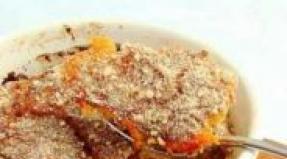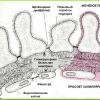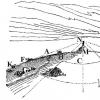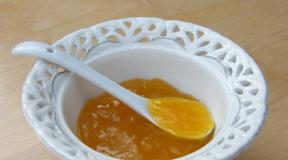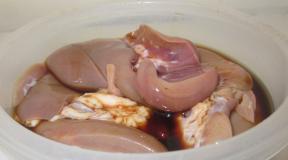Tarutino maneuver (brief description). Tarutino March, or Kutuzov’s secret maneuver What was the Tarutino maneuver
Tarutino maneuver of 1812 - a march-maneuver of the Russian army during the Patriotic War from Moscow to Tarutino (a village on the Nara River, 80 kilometers southwest of Moscow, now Kaluga region), carried out under the leadership of Field Marshal General Mikhail Illarionovich Kutuzov 5 - September 21 (September 17 - October 3, new style).
After the Battle of Borodino, when it became obvious that it was impossible to hold Moscow with the remaining forces, Mikhail Illarionovich Kutuzov outlined a plan, which was to break away from the Napoleonic army and take a flank position in relation to it, create a threat to French communications, and prevent the enemy from entering southern regions of Russia (not devastated by war and rich in supplies) and prepare the Russian army for a counteroffensive.
Kutuzov kept his plan a great secret. On September 2 (14), leaving Moscow, the Russian army headed southeast along the Ryazan road.
On September 4 (16), after crossing the Moscow River at Borovsky Perevoz (not far from the present city of Zhukovsky), Kutuzov, under the cover of the rearguard of General Nikolai Nikolaevich Raevsky, unexpectedly turned the main forces of the Russian army to the west.
The Cossacks of the rearguard managed to carry away the vanguard of the French army with a demonstrative retreat to Ryazan. It must be said that while covering the retreat, the Cossacks imitated a retreat two more times, and the French followed them along the Kashira and Tula roads.
The vanguard of General Mikhail Andreevich Miloradovich and the detachment of Nikolai Nikolaevich Raevsky were advanced towards Moscow; detachments were allocated for partisan actions.
Having lost sight of the Russian army, Napoleon sent strong detachments along the Ryazan, Tula and Kaluga roads. They searched for Kutuzov for several days, and only on September 14 (26) the cavalry of Marshal Joachim Murat discovered Russian troops in the Podolsk area.
Subsequently, Kutuzov secretly (mostly at night) retreated along the Old Kaluga Road to the Nara River.
On September 21 (October 3, new style), Russian troops stopped near the village of Tarutino, where they occupied a new fortified position. The brilliantly organized and executed Tarutino maneuver allowed the Russian army to break away from Napoleon's army and occupy an advantageous strategic position, which ensured its preparation for a counteroffensive.
As a result of the Tarutin maneuver, Kutuzov maintained communications with the southern regions of Russia, which made it possible to strengthen the army, cover the arms factory in Tula and the supply base in Kaluga, and maintain contact with the armies of Alexander Petrovich Tormasov and Pavel Vasilyevich Chichagov.
Napoleon was forced to abandon the attack on St. Petersburg and ultimately, leaving Moscow, retreat along the Old Smolensk Road, that is, through areas already devastated by the war. The Tarutino maneuver revealed Kutuzov’s outstanding leadership talent, his ability to impose his will on the enemy, put him in unfavorable conditions, and achieve a turning point in the war.
Tarutino camp
Tarutinsky camp is a fortified camp in the Tarutino region (a village on the Nara River, now Zhukovsky district of the Kaluga region, 80 kilometers southwest of Moscow), which was occupied by the Russian army from September 21 (October 3, new style) to October 11 (23) during the Patriotic War of 1812 after leaving Moscow.
The Tarutino camp was located on an area favorable for defense, relying on which it was possible to keep under surveillance the roads from Moscow - Old Kaluga, Tula and Ryazan.
The front and left flank of the Tarutino camp were covered by rivers (Nara and others), earthen fortifications in the form of flashes and lunettes (14 in total) were built along the front, and the river banks were escarped.
In the forest area that covered the rear of the Tarutino camp, abatis and rubble were built. The army was located on both sides of the Old Kaluga Road: in the 1st line - the 2nd and 6th infantry corps, in the 2nd - 4,5,3 and 7th infantry and 1st cavalry corps, in the 3rd - 8th Infantry Corps and part of the cavalry, in the 4th - two cuirassier divisions and reserve artillery (about 400 guns).
Flashes are field (sometimes long-term) fortifications. They consist of two faces, each 20 - 30 meters long, at an obtuse angle. The corner has its apex facing the enemy.
A lunette is an open field or long-term fortification consisting of at least 3 faces. The field lunette usually housed 1 - 4 companies.
To cover the flanks of the battle formation, the following were advanced: left - 5, right - 2 ranger regiments; the vanguard of the army (2nd and 4th cavalry corps) was located 3 kilometers north of Tarutino.
Mikhail Illarionovich Kutuzov’s apartment and his headquarters were located first in Tarutino, and then in the village of Letashevka (currently the Maloye Litashovo tract, 3 km southwest of Tarutino).
In the Tarutino camp, the Russian army was reorganized, re-equipped, supplied with weapons, ammunition and food, and prepared for active offensive operations. Army partisan detachments were sent behind enemy lines.
In connection with the preparation of the counteroffensive, the number of cavalry in the army increased significantly. The troops carried out intensive combat training. Kutuzov used his stay in the Tarutino camp to prepare for the Russian army to launch a counter-offensive and already in the Tarutino battle on October 18 (October 6) he defeated the vanguard of the French army.
In 1834, with the money of the peasants of the village of Tarutino and nearby villages, a monument was erected at the entrance to the village with the inscription: “In this place, the Russian army under the leadership of Field Marshal Kutuzov, strengthened, saved Russia and Europe.”
By the way, it was in the Tarutino camp that the great Russian poet, and then lieutenant of the Moscow militia, Vasily Andreevich Zhukovsky wrote the poem “A Singer in the Camp of Russian Warriors,” which made him famous throughout Russia.

The Nara River in the Tarutino region. The river served as a natural strategic barrier that protected the Russian army.

From the high slopes of the river valley the surrounding area could be seen many miles ahead.

The clear edges of the lunettes are still clearly visible on the ground.

Here and there in the vicinity of Tarutin you can find ditches and ramparts of ancient fortifications.

Monument in Tarutino.
Battle of Tarutino
The Battle of Tarutino or the Battle of Tarutino is a battle between Russian and French troops on October 6 (October 18, new style) during the Patriotic War of 1812 near the Chernishnya River (a tributary of the Nara River) 8 kilometers north of the village of Tarutino. The participants themselves called the battle “The Battle of Chernishneya” (Kutuzov) or “The Battle of Vinkovo” (Caulaincourt). Vinkovo is the old name of the current village of Chernishnya.

Battle of Tarutino
At the beginning of October 1812, having completed the preparation of the Russian army for a counter-offensive, Mikhail Illarionovich Kutuzov directed the first blow against the French vanguard (28 thousand people, 187 guns, under the command of Marshal Joachim Murat), located on the banks of the Chernishnya River.
Kutuzov’s plan was to deliver the main blow with the group of General Leonty Leontyevich Bennigsen (3 infantry and 1 cavalry corps, 10 Cossack regiments) against the left flank, and the group of General Mikhail Andreevich Miloradovich (2 infantry corps, guard and reserve cavalry) together with the main forces of the Russian army - against the center of the French vanguard, in cooperation with the partisan detachments of Ivan Semenovich Dorokhov and Alexander Samoilovich Figner, advancing behind enemy lines, to encircle and destroy him.
At 7 o'clock in the morning on October 6 (18), the Cossack regiments of Vasily Vasilyevich Orlov-Denisov attacked the French in the village of Teterinka, creating a threat of enveloping their left flank. Behind them, the advanced units of the main forces of Bennigsen’s group began to attack. The position of the French avant-garde became critical. Murat retreated. Russian troops (Orlov-Denisov's Cossacks and Miloradovich's cavalrymen) pursued them to Spas-Kupli.
The main forces of the Russian army, which advanced to the Chernishnya River, were not brought into battle: Kutuzov, having received a report about the withdrawal of Napoleon’s troops from Moscow, stopped them and returned them to the Tarutino positions.
The result of the Tarutino battle was the partial defeat of the French vanguard, which lost about 2,500 (according to other sources - 4,000) people killed and wounded, 2,000 people captured, 38 guns and the entire convoy. Russian losses amounted to 300 people killed and 904 people wounded (according to Kutuzov’s report). According to the inscription on the wall of the Cathedral of Christ the Savior, the Russian army lost 1,183 people killed and wounded.
The Battle of Tarutino was the first major tactical victory of the Russian army after the Battle of Borodino, strengthening the morale of its troops on the eve of the counteroffensive.

Bust of Ataman Platov at the war memorial near the village of Kuzovlevo (not far from Chernishni).
The Cossacks of Ataman Platov accomplished many feats during the Battle of Tarutino. Near the village of Teterinki, the Cossacks captured a French battery of 18 guns. Captain Kostin especially distinguished himself by being the first to capture a French gun. The centurion of the Karps captured the golden standard of the 1st Cuirassier Regiment. Sergeant Filatov stabbed General Deri, the commander of Murat's guard. During the battle, more than 170 Cossacks were killed, but they themselves destroyed almost 2,000 French.
Although, there are other opinions about the Cossacks, such as the memoirs of General A.P. Ermolov: "...Rich carts were a tasty bait for our Cossacks: they took up robbery, got drunk and did not think of preventing the enemy from retreating".

Memorial sign near the village of Chernishnya.
The Tarutino maneuver of the Patriotic War of 1812 is an important stage on the path to victory over Napoleon’s army. The Tarutino march-maneuver of the Russian army - from Moscow to the village of Tarutino, located on the Nara River, 80 kilometers southwest of Moscow - was carried out from September 17 to October 3 (from September 5 to 21, old style) 1812.
After the Battle of Borodino, it became obvious that it was impossible to hold Moscow with the remaining forces without replenishment of reserves. Then the commander-in-chief of the Russian army, General Field Marshal Mikhail Kutuzov, outlined a plan. It was necessary to break away from the enemy and take a position that would cover Russian supply bases in Tula and Kaluga and threaten the operational line of Napoleonic troops, in order to gain time and create conditions for launching a counteroffensive.
On September 14 (2 old style), leaving Moscow, Russian troops headed southeast along the Ryazan road. On September 17 (5, old style), after crossing the Moscow River at the Borovsky Bridge, Kutuzov, under the cover of the rearguard of Lieutenant General Nikolai Raevsky, secretly from the enemy, turned the main forces of the army to the west. The Cossacks of the rearguard managed to carry away the vanguard of the French army with a demonstrative retreat to Ryazan.
On September 19 (7 old style), the Russian army arrived in Podolsk, and two days later - in the area of the village of Krasnaya Pakhra, where it camped, closing the Old Kaluga Road.
The vanguard of Infantry General Mikhail Miloradovich and Raevsky’s detachment were advanced towards Moscow, and detachments were allocated for partisan operations.
Having lost sight of the Russian army, Napoleon I sent strong detachments along the Ryazan, Tula and Kaluga roads to search for it.
On September 26 (September 14, old style), the cavalry corps of Marshal Joachim Murat discovered Russian troops in the Podolsk region. Subsequently, Kutuzov secretly (mostly at night) withdrew the army along the Old Kaluga Road to the Nara River.
The skillfully organized and carried out Tarutino maneuver allowed the Russian army to break away from the enemy and occupy an advantageous strategic position, which ensured its preparation for a counter-offensive. As a result of the maneuver, Kutuzov maintained communication with the southern regions of Russia, which made it possible to strengthen the army, cover arms factories in Tula and the supply base in Kaluga, maintain contact with the 3rd Reserve Observation Army of cavalry general Alexander Tormasov and the Danube Army of Admiral Pavel Chichagov.
The Tarutino maneuver demonstrated Kutuzov’s leadership talent and his art of strategic maneuver.
(Additional
Having learned about the losses, Kutuzov did not resume the battle the next day. Even in the event of success and the advance of his army, the position of the Russians remained precarious. They did not have any reserves in the area from Moscow to Smolensk (all warehouses were made in Belarus, where the war was initially supposed to be waged). Napoleon had large human reserves outside Smolensk. Therefore, Kutuzov believed that the time to go on the offensive had not yet come, and ordered a retreat. True, he hoped to receive reinforcements and did not exclude the possibility of giving a new battle already near the walls of Moscow. But hopes for reinforcements did not materialize, and the position chosen for the battle near the city turned out to be unfavorable. Then Kutuzov took upon himself the responsibility to surrender Moscow. “With the loss of Moscow, Russia is not yet lost... But if the army is destroyed, the Moscow, And Russia", - said Moscow Kutuzov Russia at the military council in Fili to his generals. Indeed, another army capable of dealing with Napoleon didn’t have it. So, the Russians left their ancient capital, which for the first time in 200 years found itself in the hands of foreigners. Russia Leaving Moscow, Russia covered the southern regions of Russia, rich in human resources and food, the Tula military-industrial complex and at the same time could threaten the communications of the French on the Smolensk road. The French could not freely advance from Moscow to St. Petersburg, having the Russian army in the rear. Thus, Kutuzov actually imposed the further course of the campaign on Napoleon. In the Tarutino camp, the Russian army received reinforcements and increased its strength to 120 thousand people.
Patriotic War, 1812). The transition of the Russian army under the command of Field Marshal M.I. Kutuzov from Moscow to the village of Tarutino September 5-21, 1812. After the Battle of Borodino, Kutuzov took upon himself the responsibility of surrendering Moscow to the French in order to preserve the army. “With the loss of Moscow, Russia is not yet lost... But if the army is destroyed, both Moscow and Russia will perish,” Kutuzov told the generals at the military council in Fili. So the Russians left their ancient capital, which for the first time in 200 years found itself in the hands of foreigners. Leaving Moscow, Kutuzov began to retreat in a south-eastern direction, along the Ryazan road. At the same time, the Cossack units and the corps of N.N. Raevsky continued to retreat to Ryazan, and then “dissolved” in the forests. By this they misled the French vanguard of Marshal I. Murat, who followed on the heels of the retreating army, and the Russians broke away from the pursuit. Murat overtook the Russian army for the second time in the Podolsk region. However, attempts to attack it were stopped by the rearguard of General M.A. Miloradovich. He withstood a number of battles, not allowing the French cavalry to disrupt the ranks of the retreating army (see Spas Kuplya). During the retreat, Kutuzov introduced strict measures against desertion, which began in his troops after the surrender of Moscow. Having reached the Old Kaluga Road, the Russian army turned to Kaluga and, crossing the Nara River, set up camp in the village of Tarutino. Kutuzov brought 85 thousand people there. available personnel (together with the militia). As a result of the Tarutino maneuver, the Russian army escaped the attack and took an advantageous position. While in Tarutino, Kutuzov covered the southern regions of Russia, rich in human resources and food, the Tula military-industrial complex, and at the same time could threaten the communications of the French on the Smolensk road. The French could not freely advance from Moscow to St. Petersburg, having the Russian army in the rear. Kutuzov actually imposed the further course of the campaign on Napoleon. The main thing is that the Russian commander, having preserved the army, received all the advantages of his position - the owner of his own land. In the Tarutino camp, the Russian army received reinforcements and increased its strength to 120 thousand people. One of the most significant additions was the arrival of 26 Cossack regiments from the Don region. The share of cavalry in the Kutuzov army increased significantly, reaching a third of its strength, which played an extremely important role during the period of persecution of Napoleonic troops. The issue of providing the cavalry with everything necessary was thought out in advance; in particular, more than 150 thousand were delivered to the army. horseshoes In addition to human reserves, the army received significant logistical support in a short time. In August-September alone, the country's main weapons forge, the Tula Plant, produced 36 thousand guns for the army. Kutuzov also entrusted the Tula, Kaluga, Oryol, Ryazan Itver governors with the responsibility of procuring 100 thousand sheepskin coats and 100 thousand pairs of boots for the army. Despite all its tactical achievements, the French army in Moscow found itself in a strategic blockade. In addition to the Tarutino camp, where Kutuzov’s troops were stationed, a second army was actually created around Moscow, consisting of partisans and militias. Its number reached 200 thousand people. Having reached the ancient Russian capital, Napoleon's army found itself in a tight blockade ring. Napoleon, who came to a country deeply alien to him, was unable to create his base here and found himself in isolation. The only thread connecting the French with the familiar world was the Smolensk road, along which they carried out a constant supply of provisions, ammunition and fodder to Moscow. But it was under the control of partisan detachments and could be tightly blocked at any moment by an attack from Tarutino. At the same time, Napoleon's hopes that the capture of Moscow would force the Russians to make peace were not justified due to the tough position of Alexander I, who was determined to continue the fight. During his stay in Moscow, Napoleon lost 26 thousand people. killed, missing, died from wounds and diseases, i.e. suffered losses comparable to a major battle. Gradually, the illusory nature of success from the French occupation of Moscow became quite obvious. All this forced Napoleon to leave Moscow. In 1834, in Tarutino, using funds raised by peasants, a monument was erected with the inscription: “In this place, the Russian army under the leadership of Field Marshal Kutuzov, strengthened, saved Russia and Europe” (see Cherniishya, Maloyaroslavets).
The Tarutino maneuver under the leadership of Field Marshal Mikhail Kutuzov is one of the outstanding strategies in Russian military affairs. This maneuver was carried out during the Patriotic War of 1812 in the direction from the capital of the Russian state to the village of Tarutino, which is 80 kilometers from Moscow, in the territory of the present Kaluga region, from September 5 to 21, old style.
In contact with
Classmates
Tarutino maneuver: Wikipedia
According to the electronic encyclopedia, the Tarutino maneuver is a strategy that Kutuzov prepared with the aim of getting extra time to prepare for battle with the French army. The French army was defeated here, and the Russians achieved their first victory in the War of 1812 and managed to launch a counteroffensive.
What is the cause of the Patriotic War of 1812?
The French Revolution ended with the ascension to the imperial throne, which negatively affected relations between Russia and France. This relationship deteriorated for several reasons:
- Alexander I was afraid that a similar revolution would break out in Russia;
- Napoleon's aggressive policy towards some European countries, and, in particular, towards England, with which the Russian Empire was an ally.
Once two friendly powers, Russia and France, now find themselves on the battlefield as opponents.
 By the beginning of 1812, the entire European territory (except England) had been conquered by Napoleon I, and only the Russian Empire continued its independence from others foreign policy, as well as trade relations with England, although this contradicted the previously concluded Tilsit Agreement, where the most important condition was a continental blockade against England. However, Russia and England now maintained their trade relations through other European countries, which corresponded to the conditions of this blockade, but Napoleon was still very angry about this fact.
By the beginning of 1812, the entire European territory (except England) had been conquered by Napoleon I, and only the Russian Empire continued its independence from others foreign policy, as well as trade relations with England, although this contradicted the previously concluded Tilsit Agreement, where the most important condition was a continental blockade against England. However, Russia and England now maintained their trade relations through other European countries, which corresponded to the conditions of this blockade, but Napoleon was still very angry about this fact.
The independent policy of the Russian Empire destroyed the plans of the Emperor of France for world domination, so war between these states was inevitable. The French emperor hoped to inflict a crushing blow on Russia already at the first battle and force Alexander I to dance to his tune.
Actions that prompted the development of the Tarutino maneuver
The battle of Borodino made it clear to the Russian army that the capital of the state with the help of the remaining strength it is not possible to keep it. Then Kutuzov drew a plan on the map, according to which it was necessary:
- break away from the French army;
- prevent the passage of the enemy army to the southern latitudes of the country, where large food reserves were located;
- try to destroy the communications of Napoleon's army and prepare for a counter-offensive.
The Military Council in Fili decided that it was necessary to leave Moscow and develop escape routes for the Russian army. It was decided to retreat towards Ryazan.
Preparation and execution of the Tarutino maneuver
When the army crossed the Moscow River, Kutuzov gave the order to the main forces to move west, and convoys guarded by Cossacks set off along the Ryazan road, and they took the French army behind them. Cossacks still “faked” retreat twice and led Napoleon's army along the Tula and Kashira roads. Thus, the French had no idea where the Russian troops were actually moving.
On September 7, the main forces of the Russian army approached Podolsk, and a couple of days later they were already near the village of Krasnaya Parkha, a camp was set up here and Russian troops settled in it until September 14.
Napoleon began to suspect that the command of the Russian army wanted to make a surprise attack, so he was ordered to throw all his efforts into searching for the main strength of the Russian army. Divisions under the command of Delzon, Ney, Davout would be sent to the northern, southern and eastern directions from Moscow, and the troops of Murat, Bessier and Poniatowski examined every corner south of the capital. And only on September 14, the French, or rather Murat’s troops, were able to detect Russian troops near Podolsk.
 This position of the army of the Russian Empire was convenient for battle, if suddenly the troops under the command of French military leaders decided to attack. However, if Napoleonic army decided to engage in hostilities, Bonaparte could quickly bring reinforcements to Podolsk, so Kutuzov decided to “move” the troops further to Krasnaya Parkha. Near Podolsk itself there are only a few combat posts of the Russian army.
This position of the army of the Russian Empire was convenient for battle, if suddenly the troops under the command of French military leaders decided to attack. However, if Napoleonic army decided to engage in hostilities, Bonaparte could quickly bring reinforcements to Podolsk, so Kutuzov decided to “move” the troops further to Krasnaya Parkha. Near Podolsk itself there are only a few combat posts of the Russian army.
The advanced troops of General Miloradovich, a detachment led by Raevsky, as well as partisan detachments were sent towards the capital. Retreating, these troops burned all the crossings.
The march of the Russian army was also helped by peasants who, together with the Cossacks, attacked the advanced reconnaissance troops of the French, thereby causing serious damage to the enemy.
After the French discovered the direction of retreat of the Russian army, Kutuzov ordered troops to move along the Nara River towards Tarutino at night.
Strengthening positions near the village of Tarutino
Near the village of Tarutino, the Russian army camp stood from September 21 to October 11 (these dates are indicated according to the old style). This camp is located in a very advantageous position, from which one could observe all the roads leading from Moscow.
The camp was protected from the front and left flank by rivers, on the banks of which additional earthen fortifications were also built. The rear of the camp was covered by a forest, where rubble and abatis had been prepared.
In the Tarutino camp, a reorganization of the army took place: additional forces, new weapons and ammunition arrived, food supplies replenished, a plan of offensive action was developed, partisan detachments were sent towards the enemy army. The number of cavalry increased sharply as a counterattack was planned, and many soldiers received combat training.
The Napoleonic army that entered Moscow fell into a trap, since the capital was surrounded by partisan Cossack and peasant detachments, and the southern borders of Russia were defended by the newly recruited army of the Russian Empire.
The significance of the march maneuver in the Patriotic War of 1812
 A well-thought-out and perfectly executed maneuver made it possible not only to confuse Napoleon’s army and gain time to prepare defensive measures, but also to develop a plan for a counterattack. In addition, Kutuzov was able to protect from attack the French south coast, due to which the domestic army was able to strengthen its power. In addition, the Tula arms factory and the Kaluga supply base still remained untouched by the French troops and provided their own army with supplies.
A well-thought-out and perfectly executed maneuver made it possible not only to confuse Napoleon’s army and gain time to prepare defensive measures, but also to develop a plan for a counterattack. In addition, Kutuzov was able to protect from attack the French south coast, due to which the domestic army was able to strengthen its power. In addition, the Tula arms factory and the Kaluga supply base still remained untouched by the French troops and provided their own army with supplies.
Thanks to this, Kutuzov maintained contact with the troops of Chichagov and Tormasov, who took up defensive positions near St. Petersburg. He came up with a brilliant plan for how to encircle Napoleon’s army and subsequently completely defeat it.
On October 6, Kutuzov decided to attack Murat’s troops, who also set up their camp near Tarutino. The troops of this commander could not be completely defeated, since most of them decided to retreat.
Seeing the increased power of the Russian army, the French emperor decided not to attack St. Petersburg, liberate the capital and begin a retreat along the road through Smolensk, that is, through those areas that have already been ravaged by the fighting.
